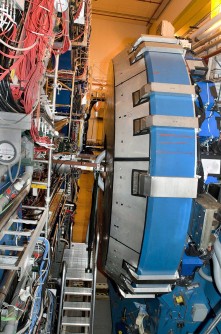Nuclear scientists used a new theoretical approach to calculate a value essential for unraveling the three-dimensional motion of quarks within a proton. The researchers obtained a significantly more accurate picture of these internal building blocks’ transverse motion. The work will aid in calculations of 3D motion of quarks and gluons in future collider experiments.
Tag: Quarks
Scientists Gain New Insights into How Mass Is Distributed in Hadrons
The trace anomaly is one of the quantities that encodes the energy and momentum of particles built from quarks. Scientists believe the trace anomaly is crucial for keeping quarks bonded in subatomic particles. In this study, scientists calculated the trace anomaly for nucleons and pions. The calculations show that in the pion, the mass distribution is similar to the charge distribution of the neutron and in the nucleon, the mass distribution is similar to the charge distribution of the proton.

Theory Thesis Wins APS Dissertation Award
Zhite Yu has been awarded the 2024 J.J. and Noriko Sakurai Dissertation Award in Theoretical Particle Physics. The award was presented to Yu at the APS April Meeting in Sacramento, where he also delivered a talk about his work.
Teasing Strange Matter from Ordinary
Like protons and neutrons, Lambda particles consist of three quarks bound together by gluons. But unlike protons and neutrons, which contain a mixture of up and down quarks, Lambdas also contain a strange quark.
Calculation Shows Why Heavy Quarks Get Caught Up in the Flow
Theorists have successfully calculated the “heavy quark diffusion coefficient,” which describes how quickly a melted soup of quarks and gluons transfers its momentum to heavy quarks. The results show this transfer is very fast—at the limit of what quantum mechanics will allow.
The Strength of the Strong Force
Researchers have experimentally extracted the strength of the strong force, a quantity that firmly supports theories explaining how most of the mass or ordinary matter in the universe is generated. This quantity, known as the coupling of the strong force, describes how strongly two bodies interact or “couple” under this force. With Jefferson Lab data, the physicists were able to determine the strong force coupling at the largest distances yet.
Postdoc Extracts Exotic Particle Properties
The 2022 JSA Postdoctoral Prize winner, Arkaitz Rodas, characterizes lesser-known particles to help physicists understand what holds matter together. Rodas will characterize light mesons using computational mathematical tools for his prize-winning project.
Department of Energy Names Three Office of Science Distinguished Scientists Fellows
The U.S. Department of Energy (DOE) named three National Laboratory scientists as DOE Office of Science Distinguished Scientists Fellows

Analyzing Matter’s Building Blocks
Nobuo Sato is working to put the know in femto. He’s just been awarded a five-year, multimillion dollar research grant by the Department of Energy to develop a “FemtoAnalyzer” that will help nuclear physicists image the three-dimensional internal structure of protons and neutrons. Now, Sato is among 76 scientists nationwide who have been awarded a grant through the DOE Office of Science’s Early Career Research Program to pursue their research.

Theorist Takes Aim at the Makeup of Matter
Quarks and gluons are elementary particles that make up everything you see before you, including yourself, and Nobuo Sato wants to know how. At the Department of Energy’s Thomas Jefferson National Accelerator Facility, he will be tackling this question as the recipient of the JSA/Jefferson Lab Nathan Isgur Fellowship for Nuclear Theory.

STAR Gains Access to “Wimpy” Quarks and Gluons
Low-momentum (wimpy) quarks and gluons contribute to proton spin, offering insights into protons’ behavior in all visible matter. The Science The “proton spin puzzle” concerns how much the building blocks of the proton, quarks and gluons, and their motion within…